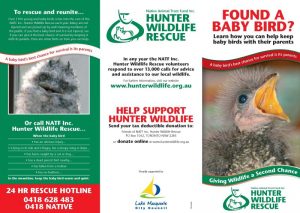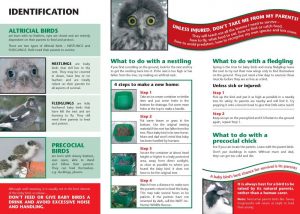Baby Birds
Often, “rescues” for baby birds are unnecessary and can be detrimental to the survival of the animal.
Each spring, volumes of healthy fledgling birds come into care when well-meaning people find them on the ground and see no parents immediately nearby. Even the best carer can’t teach them what they should learn from their parents, and resources are best used on truly orphaned and/or injured birds!
Our “Found a Baby Bird?” pamphlet can be helpful in deciding if the bird needs to be left alone or if it may need to come into our care.
If you find a baby bird, do not attempt to look after, feed or hydrate it. If it is injured or in imminent danger, place it in a dark, warm, dry place away from pets, and contact our hotline. If not you should;
• Resist the urge to “rescue”!
Observe from afar instead. The parents are unlikely to return whilst you are interfering directly with their baby. In the case of nocturnal species like the tawny frogmouth, they may even be asleep.
• Try to return it to the nest (or make one)
A small box or ice cream container with drainage holes makes an excellent temporary nest. Secure the nest in a tree as close as possible to where the chick was found.
Check if the parents come to feed the chick over the next few hours. If they don’t, if the chick is showing signs of illness, injury, weakening condition, or is attacked by other birds, call our hotline and one of our rescuers can bring the animal into care.
Hint: If the bird is pooping – he’s likely being fed!
Our “Found a Baby Bird?” pamphlet can be helpful in deciding if the bird needs to be left alone or if it may need to come into our care.
DIY Improvised Nest
Step 1
Take an ice-cream container or similar item and put some holes in the bottom for drainage. Put some more holes at the top to make a handle.

Step 2
Put some leaves or grass in the bottom. Use the original nesting material if the nest has fallen from the tree. Place baby bird in its new home. Mum and dad won’t mind that baby has been handled by humans.

Step 3
Secure the container at about head height or higher in a leafy protected area, away from direct sunlight, as close to where you found the baby bird. It does not even have to be the original tree.

Step 4
Watch from a distance to make sure the parents return to feed baby. This may take several hours so be patient. If the parents have not returned by dark, call the Hunter Wildlife Rescue.



